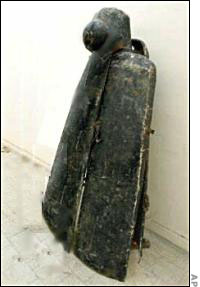In fact, as American intelligence officials told NBC news in 2003, Uday Hussein actually seemed to blossom under the oppressive sanctions. According to a piece written by NBC producer Robert Windrem in October 2003, "Uday, 36, has flourished amid Iraq's nightmare of war, sanctions and starvation by taking charge of the black market, according to U.S. intelligence officials.
American and international officials had long complained, as Windrem put it, "it is Uday who arranges sales of Iraqi oil as well as purchases of meat and other food."
And with his ruthless but entrepreneurial instincts, Uday also found other avenues to make money. "Among his newest moneymaking schemes are leasing soccer players to European and Asian teams — Iraqis are well known in this sport," Windrem reported. He also found a way to extract a profit out of the misery of the so-called swamp Arabs, the Shi'ites who lived in the marshlands of southern Iraq and had come under attack by Saddam after an ill fated uprising after the first Gulf War. Uday, according to Windrem, took it upon himself to sell licenses for bird hunting in the marshes.
But it was the sanctions prohibiting the sale of much of Iraq's oil that helped generate the largest profits for Uday Hussein. According to the dissident, London-based Iraqi National Congress, Uday's control of a number of Iraqi companies designated to deal with the United Nations on food and other humanitarian efforts, allowed him to make millions. As Windrem put it, "the dissident group says he made a profit of $10 million alone on one deal for kerosene in 1992." By some accounts, before the American led invasion, Uday Hussein earned upwards of $100 million a year.
But it was his other passion, sports, which cemented Uday Hussein's international infamy. According to Yaeger's detailed report in Sports Illustrated, Uday first assumed control of the Iraqi Olympic committee and its soccer federation in 1984, when he was just 20 years old. As Yaeger put it, Saddam had hoped "Uday could help rebuild the spirit of the nation's youth while also proving himself a worthy successor to his father. The Iran-Iraq war, which would drag on for eight years and lead to the death of hundreds of thousands of young Iraqis, was demoralizing Iraqi youth. Success in sports, Saddam thought, could lift their spirits and restore national pride.
It didn't work out that way.
 |
| Uday Hussein at Olympics |
In fact, by all accounts, Uday Hussein's tenure at the Iraqi Olympic Committee was nothing short of a reign of terror. A security guard at the Iraqi Olympic committee reportedly had his hands cut off after he was wrongly accused of stealing sports equipment, team members were beaten and tortured, in some cases they simply vanished when their performance in competition failed to meet Uday Hussein's lofty standards. There were reports that athletes had their toenails pulled out for displeasing Uday, and in other cases had the soles of their feet beaten or scalded. The irony is that Uday's brutal tactics did little to improve the performance of Iraqi athletes. In fact, as Yaeger reported, it had exactly the opposite effect. When the time rolled around to send a team to the 200 Olympic Games in Sidney, Iraq could muster just four athletes because no one wanted to risk life and limb to play for the national team. Two decades earlier, before Uday's reign of terror began, Iraq had fielded 46 Olympians.
It should come as no surprise that, though the international Olympic governing body and others investigated the allegations of abuse, they were never able to prove them while Uday was alive an in a position of power. After all, if one risked beatings or death for simply losing a game in double overtime, it was hard to imagine what the consequences might have been for actually betraying Uday Hussein.
 |
| An Iron Maiden |
But it is interesting to note that after the fall of Saddam's Iraq, an artifact was discovered that supported the allegations of brutality. Buried under a pile of dead leaves in a courtyard behind the Olympic National Committee's central Baghdad compound, a reporter for Time magazine in April 2003, found an "iron maiden" a coffin-like medieval torture device, lined with sharps spikes designed to impale its victims. As the reporter, Aparisim Ghosh wrote, the 7-foot tall sadistic sarcophagus "was clearly worn from use, its nails having lost some of their sharpness."



